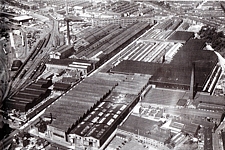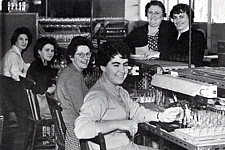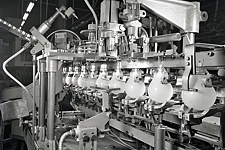|
|
|
Introduction
The Strand Road works has a long history, having been established in 1911 as one of the first factories engaged in the production of the tungsten filament lamp. Although founded by English Electric its turbulent history served many other owners including Dick Kerr, British Siemens, AEI and finally Thorn Lighting, who closed it owing to duplication of operations available in other factories. Under the Siemens era it prospered for many years and its laboratories created many firsts, especially in the field of discharge and projection lamps.
|
 Company Float for the Preston Guild of 1922, photographed outside the factory from the North of Watery Lane
Company Float for the Preston Guild of 1922, photographed outside the factory from the North of Watery Lane
|
| Address |
Corner of Strand Road and Watery Lane, Preston, Lancashire, United Kingdom |
| Location |
53.7632°N , -2.7237°E |
| Opened |
1911 |
| Closed |
1964-69 |
| Products |
Incandescent, Fluorescent, Mercury Medium and High Pressure, Xenon, Neon, Incandescent Projection, Fluorescent Starters, Surge Protectors, Barretters, Vacuum gauages and many kindred evacuated glass electrical devices. |
Early History
The history of the founding company, the English Electric Manufacturing Company, can be traced back to 1899 when it established a vast complex along Strand Road in Preston for the manufacture of heavy electrical goods. Items such as motors, transformers, turbines and electric trams were the staple business of that company. In 1902 the operations were taken over by Dick, Kerr & Co., a company which quickly became world famous for its electric trams. The lighting of the early trams presented a number of difficulties in view of the severe vibrations that had to be endured, and Dick Kerr quickly become a rather large consumer of lamps having specially reinforced construction for vibration service. As part of its growing electrical empire, the company developed ambitions to maufacture its own lamps, and in parallel enter the highly profitable lighting market.
Consequently in 1911 a lamp factory was established within the Dick Kerr works. So vast was their manufacturing site and so few are the early records that it has not been possible to trace whether or not the original production was established in the building illustrated above, but that was certainly in existence by 1922, the date of the photograph. The building is known as Oyston Mill although local historians question the significance of that name, as the factory is believed to have been constructed right from the outset as a lampworks rather than a mill. It produced lamps under the name of Dick, Kerr & Co. Ltd, frequently also accompanied by the brand name "Britannia".
|
Transition from English Electric to Siemens
The German company founded as Siemens & Halske has a long history in the UK, stretching back to 1858 when Werner Siemens sent his brother William to London to establish an overseas sales operation. Manufacturing soon followed in 1863 when a factory was opened in Woolwich to produce electrical cables. On account of the strong national interests in buying British products at the time, steps were taken to make the company appear as British as possible. By 1888 the British operations were re-named Siemens Brothers and became a separate entity from the German parent, but Siemens & Halske still maintained a substantial shareholding in the British factory. In 1908 Siemens Bros. expanded its operations to include lampmaking, with a new factory in Dalston, London, to manufacture the newly invented Tantalum filament lamps.
The ownership of Siemens Bros. was to change again with the outbreak of World War 1, when on 14th August 1914 all German assets were confiscated by the UK Government, and from that point onwards all contact with the German Siemens was severed. In 1917 the Custodian of Enemy Property sold Siemens Bros. to C. Birch Crisp & Co., a finacial syndicate from London. In 1919 Birch Crisp disposed of the company to English Electric Ltd. (of no connection to the earlier English Electric Manufacturing Company listed above).
As part of the restructuring of the Siemens operations into those of English Electric, it was also decided to merge with Dick Kerr and with the Coventry Ordnance Works, to create a giant electrical conglomorate. For practical reasons two subsidiary companies were formed - one to handle heavy electrical engineering, and the other to be concerned with smaller electrical appliances. The former English Electric Company was charged with focussing on the heavy side which had previously been its forte, and Siemens Bros. was to concentrate on the smaller appliances. Consequently the vast Siemens Dynamo works was split off from Siemens Bros. and integrated into English Electric. Similarly, Dick Kerr and Coventry Ordnance were also involved in the heavy electrical products, and these too were absorbed by the newly enlarged English Electric.
The integration of Dick Kerr presented just one conflict in this integration, because it was primarily a heavy electrical company but it also had a lamp factory. English Electric was reluctant to see the lampworks pass entirely into the control of Siemens Bros, because lamps were at the time a vastly profitable operation. The ensuing dispute was resolved by forming a third subsidiary in 1919, Siemens and English Electric Lamps Ltd., jointly owned by both. This took charge of the lampmaking operations in both Preston as well as the original Siemens Tantalum lamp factory in Dalston, which in the mean time had been converted to the manufacture of the more efficient tungsten lamps.
In 1921-22 this new company entered negotiations with Anton Philips of the Netherlands, who was desperate to get a foothold into the British lamps business and had a keen interest in purchasing the factory. However no deal was reached owing to the complications of the joint ownership between Siemens and English Electric.
In 1923 the Dalston factory of Siemens was closed, and all lampmaking of the group was concentrated at Preston. The company was enduring a difficult period at that time, owing to the great progress being made by competititors in lamp research which was at frequent intervals leading to newer types with improved performance, and better cost efficiency. Indeed the entire British Siemens was suffering because it had no significant research operation of its own, and prior to WW1 had relied entirely on innovations from its German parent. In 1924 the newly appointed General Manager of Siemens Bros, Dr. Henry Wright, visited the Siemens & Halske company in Berlin with the aim of rebuilding technical links. It was agreed that S&H would once again share its technical excellence with the British company, and in exchange acquired a 15% shareholding in Siemens Bros. One of the consequences of the first world war was that a limit of 25% foreign shareholding in British factories had been established by the Government, and this 15% deal allowed room for S&H to increase its shareholding at a later date in case the co-operation should prove fruitful.
The later 1920s were a particularly difficult era for English Electric whose business in the heavy electrical industry was, like its major competitors at GEC and AEI, plagued by mounting financial losses. EE was in desperate need of cash, and in 1927 accepted an offer from Siemens Bros. to buy out its share in the lamp factory, which was instantly accepted. The company name was changed again to Siemens Electric Lamps & Supplies Ltd. but it was in fact fully owned by Siemens Bros. - and of course the German Siemens & Halske still retained its 15% stake in Siemens Bros. It was a decision that EE would come to regret intensely in future years as the heavy electrical industry's financial status deteriorated from bad to worse, while the profits being earned in lamps were by contrast soaring beyond belief.
|
The Siemens Era
Under the full ownership of Siemens Bros. and with technical contacts restored to Germany, the Preston lampworks prospered immensely. In order to never again fall into a situation in which it relied on foreign technology, research laboratories were established in the English factories and this included the recruitment of several highly skilled engineers to join the Preston works. Among these were Dr. John Aldington, who was to make several breakthroughs of profound importance to the development of electric discharge lamps and would ultimately become technical director of the giant AEI organisation.
|
Transition to AEI and Thorn
In 1954 Siemens Bros. was taken over by AEI, and the lamp factory at Preston was integrated into the AEI Lamp & Lighting division. The Siemens Bros. brand name was however retained by AEI, just as it had done with its previous subsidiaries of Mazda, Metrovick and Ediswan, each of which continued trading as a separate entities within AEI.
The AEI takeover also resulted in significant rationalisation of production for Preston. The discharge lamp operations were essentially a duplication of AEI's own group at Leicester, and the decision was promptly taken to concentrate all discharge lamp production and development at that factory. Preston was retained however for the manufacture of incandescent and projection lamps, where volumes were growing rapidly and the additional capacity of that factory was a welcome addition to fuel AEI's business. Several years later AEI was coming under increasing cost pressure in incandescent lamps, and decided to pool all production in a single factory. This resulted in the closure of AEI's own GLS factory at Trent Vale around 1963-64, with all high volume standard GLS types being concentrated at Preston.
This boost to the Preston operations was to be brief however, because in 1964 controlling interest in AEI Lamp & Lighting Company was acquired by Thorn Lighting. With immediate effect the transitional company British Lighting Industries was formed to amalgamate Thorn's lampmaking operations with AEI's subsidiaries of Mazda, Ediswan, Metrovick and of course the Siemens operation. It's owner Sir Jules Thorn was determined to do away with the inefficiency of AEI's structure of having essentially four subsidiary lighting brands, each with its own sales network and dedicated factories for each brand, and to bring the entire operations into one single streamlined company.
Thorn had learned years earlier that in a fiercely competitive business like that of electric lamps, it never pays to skimp on investments in manufacturing. In the years before he had equipped his own factories with the fastest and most efficient lampmaking machinery in the whole of Europe. This was thanks to his technical agreements with Sylvania of America which allowed him to build advanced machinery according to the ultra-efficient American designs, the likes of which were completely absent in Europe at that time and which mass produced lamps with high efficiency at the most competitive prices. The former Siemens and AEI manufacturing at Preston could not compete alongside Thorn's vastly superior incandescent manufacturing equipment at it's Merthyr Tydfil factory in South Wales, and it was at once clear that Merthyr could easily absorb the Preston volumes. This resulted in the final closure of the Preston factory sometime during the period 1964-69.
|
Photographs
|
 |
|
 |
|
 |
|
 |
|
| Dick Kerr West Works, 1905 |
|
Preston Guild, 1922 |
|
Preston Guild, 1922 |
|
Factory on RHS c. 1940s |
|
|
 |
|
 |
|
 |
|
 |
|
| Aerial View 1950s |
|
Aerial View 1951 |
|
GLS Mounting 1952 |
|
GLS Capping 1965 |
|
Examples of Strand Road Lamps
|
 |
|
 |
|
 |
|
 |
|
 |
|
 |
| MAT Mercury Blended |
|
MA/V Mercury Coloured |
|
MA/V Mercury Coloured |
|
MB/V Quartz Mercury |
|
MBT/V Mercury Blended |
|
Telephone Line Protector |
|
 |
|
|
|
|
|
|
|
|
|
|
| Lighthouse 80v 4000w |
|
|
|
|
|
|
|
|
|
|
| 1 |
Siemens Brothers 1858-1958, J.D. Scott, Weidenfeld & Nicholson 1958, pp. 144-152 "The Preston Achievement". |
| 2 |
Anatomy of a Merger : A History of GEC, AEI and English Electric, R.Jones & O.Marriott, Pan Books Ltd, 1970. |
| 3 |
Death of a Lightbulb, J. Otten, Blue Ocean Publishing 2012, p.54. |
| 4 |
Preston Digital Archive |
| 5 |
History of GEC-Alsthom Preston |
|
|
|
|
|